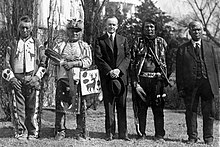
Native American recognition in the United States, for tribes, usually means being recognized by the United States federal government as a community of Indigenous people that has been in continual existence since prior to European contact, and which has a sovereign, government-to-government relationship with the Federal government of the United States. In the United States, the Native American tribe is a fundamental unit of sovereign tribal government. This recognition comes with various rights and responsibilities. The United States recognizes the right of these tribes to self-government and supports their tribal sovereignty and self-determination. These tribes possess the right to establish the legal requirements for membership.[1] They may form their own government, enforce laws (both civil and criminal), tax, license and regulate activities, zone, and exclude people from tribal territories. Limitations on tribal powers of self-government include the same limitations applicable to states; for example, neither tribes nor states have the power to make war, engage in foreign relations, or coin money.[2]
State-recognized tribes in the United States are organizations that identify as Native American tribes or heritage groups that do not meet the criteria for federally recognized Indian tribes but have been recognized by a process established under assorted state government laws for varying purposes or by governor's executive orders. State recognition does not dictate whether or not they are recognized as Native American tribes by continually existing tribal nations. Members of a state-recognized tribe are still subject to state law and government, and the tribe does not have sovereign control over its affairs. Such state recognition has at times been opposed by federally recognized tribes. For instance, the Cherokee Nation opposes state-recognized tribes, as well as Cherokee heritage groups and others with no documented descent who claim Cherokee identity.[3]
Other groups that identify as being Native American tribes but lack federal or state recognition, or recognition by the extant tribes, are listed in the List of organizations that self-identify as Native American tribes.
As of March 24, 2023[update], there are 574 tribes legally recognized by the Bureau of Indian Affairs (BIA) of the United States,[4][5] 228 of which are located in Alaska.[6] On the state level, in late 2007 about 16 states had recognized 62 tribes.[7] According to the National Conference of State Legislatures, only 14 states recognized tribes at the state level by 2017.[8]
- ^ This right was upheld by the US Supreme Court in Santa Clara Pueblo v. Martinez in 1978, which is discussed in Ray (2007) p403
- ^ "The U.S. Relationship To American Indian and Alaska Native Tribes". america.gov. Archived from the original on May 19, 2009. Retrieved February 8, 2006.
- ^ "What is a real Indian Nation? What is a fake tribe?". Cherokee Nation. Archived from the original on 12 November 2014. Retrieved 15 May 2014.
- ^ Indian Affairs Bureau (12 January 2023). "Indian Entities Recognized by and Eligible To Receive Services From the United States Bureau of Indian Affairs". Federal Register. 88: 2112–16. Retrieved 24 March 2023.
- ^ Federal Acknowledgment of the Pamunkey Indian Tribe Archived 2015-07-14 at the Wayback Machine
- ^ "Alaska Region | Indian Affairs". www.bia.gov. Retrieved 2023-03-25.
- ^ Alexa Koenig and Jonathan Stein, "Federalism and the State Recognition of Native American Tribes: A Survey of State-Recognized Tribes and State Recognition Processes across the United States", Santa Clara Law Review, Vol. 48, November 2007
- ^ "State Recognized Tribes". National Conference of State Legislatures. Archived from the original on 1 September 2022. Retrieved 6 April 2017.
